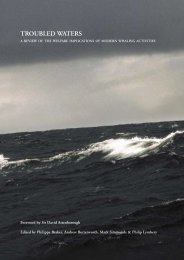Proceedings of the Untangled symposium: - WSPA
Proceedings of the Untangled symposium: - WSPA
Proceedings of the Untangled symposium: - WSPA
You also want an ePaper? Increase the reach of your titles
YUMPU automatically turns print PDFs into web optimized ePapers that Google loves.
Annex 4Submitted abstracts accompanyingposter presentationslarge-scale assessments <strong>of</strong> <strong>the</strong> distribution, abundance,and condition <strong>of</strong> benthic coral reef organisms in a variety<strong>of</strong> subtidal, ocean-side habitats from south <strong>of</strong> Miamito Key West since 1999. A stratified random samplingdesign that incorporates multiple habitat types and areasinside and outside <strong>of</strong> no-fishing zones is used to partition<strong>the</strong> Florida Keys study area. Included in this programare surveys <strong>of</strong> <strong>the</strong> type, length, weight, and impacts <strong>of</strong>marine debris to benthic organisms, as well as removal <strong>of</strong>encountered debris. The purpose <strong>of</strong> <strong>the</strong>se surveys is notto remove as much marine debris as possible, but ra<strong>the</strong>rto document <strong>the</strong> spatial distribution and amount <strong>of</strong> marinedebris and to use <strong>the</strong> stratified survey design that allowsfor estimation <strong>of</strong> <strong>the</strong> total amount <strong>of</strong> debris on <strong>the</strong> seabedfor <strong>the</strong> habitats sampled. Results from several large-scalesampling missions during <strong>the</strong> past decade indicate thatlost angling gear and lobster/crab trap gear are <strong>the</strong> mostcommon items encountered, but that marine debris ingeneral is ubiquitous throughout <strong>the</strong> ecosystem. Effortsto reduce lost fishing gear are challenging and it is likelythat entangled debris on <strong>the</strong> seabed will continue to be achronic, low-level stressor in <strong>the</strong> Florida Keys.Addressing <strong>the</strong> threat posed by marine debris towildlife in <strong>the</strong> deep oceansMark Peter SimmondsSenior Associate Marine ScientistHumane Society Internationalmark.simmonds@sciencegyre.co.ukEntanglement in marine debris raises very severe animalwelfare issues. For example, entangled marine mammalsmay struggle in discarded fishing nets for long periods<strong>of</strong> time before <strong>the</strong>y finally succumb. Efforts related toentanglement <strong>of</strong> wildlife in debris is largely focused closeinshore and on land, for example in nesting and hauloutsites. Clean-ups have focused primarily on <strong>the</strong> seashore and shallow areas accessible to snorkelers andscuba divers. However, <strong>the</strong>re is evidence <strong>of</strong> <strong>the</strong> buildup<strong>of</strong> debris in some deeper <strong>of</strong>fshore areas. This raisesquestions about how significant deeper accumulationsmay be, where deep sea entanglement ‘hot spots’ areand how <strong>the</strong>y might be best addressed, especially given<strong>the</strong> difficulties posed by <strong>of</strong>fshore conditions.Sampling <strong>of</strong> debris found <strong>of</strong>fshore at <strong>the</strong> surface andon <strong>the</strong> deep seabed will yield evidence about sources.This would potentially allow targeting <strong>of</strong> sources, suchas certain fisheries with high levels <strong>of</strong> discards. A recentstudy in <strong>the</strong> Gulf <strong>of</strong> California using a submersible atdepths <strong>of</strong> 20-365m, found that fishing activities were <strong>the</strong>dominant contributor to debris, which was densest closeto fishing ports and consisted mainly <strong>of</strong> mon<strong>of</strong>ilamentfishing line. Elsewhere, bottom trawling has been usedto sample debris but this cannot be used where <strong>the</strong>benthos is rocky or where <strong>the</strong>re are wrecks, whichare both features where lost fishing gear is likely toaccumulate. Acoustic techniques (e.g. side scan sonar)might be used to examine <strong>the</strong> deep sea benthos and,although plastics are relatively transparent to acoustictechniques, imaging abilities are improving and soliddebris-ensnaring features can certainly be identified.(As sonars introduce sound into <strong>the</strong> marine environment,<strong>the</strong> cost-benefit <strong>of</strong> such approaches would need to becarefully weighed.)Efforts are also being made to model <strong>the</strong> dispersal <strong>of</strong> lostnets, although <strong>the</strong>se appear to be at an early stage <strong>of</strong>development. In addition, certain marine animal speciesmay act as indicators <strong>of</strong> what is happening in <strong>the</strong> deepseas, potentially including <strong>the</strong> deep-diving whales.Sampling and mapping <strong>of</strong> debris at <strong>the</strong> surface <strong>of</strong> <strong>the</strong>oceans is better developed and studies focused onmapping and assessing wildlife at <strong>the</strong> surface are alsoincreasingly systematically recording and mappingfloating debris. Such information could be usefullycompiled, along with reports <strong>of</strong> debris from o<strong>the</strong>r marineusers, into regional or international databases that mayhelp to identify <strong>of</strong>fshore areas where interactions withwildlife may be concentrated.This review will explore <strong>the</strong>se topics fur<strong>the</strong>r – drawingtoge<strong>the</strong>r information about approaches that mightlead to <strong>the</strong> improved identification <strong>of</strong> concentrations<strong>of</strong> entangling debris and <strong>the</strong>reby facilitating discussionaround this topic and, ultimately, remedial action.Debris in <strong>the</strong> deep seas is largely out <strong>of</strong> human sight,but <strong>the</strong> old adage <strong>of</strong> ‘out <strong>of</strong> sight and out <strong>of</strong> mind’ mustnot be allowed to apply to this cruel threat to wildlife anymore than it should relate to any o<strong>the</strong>r.35
















